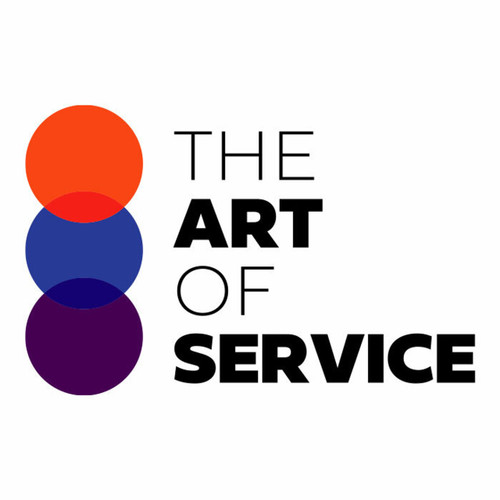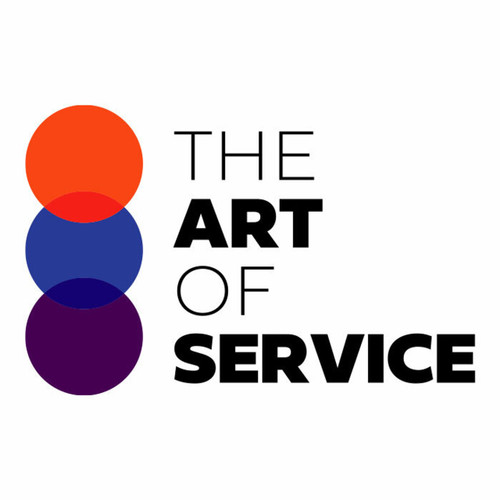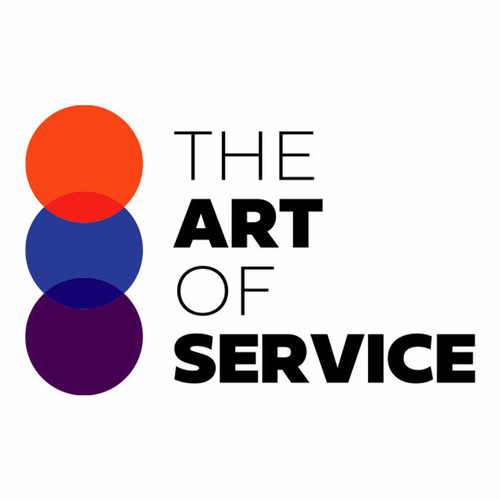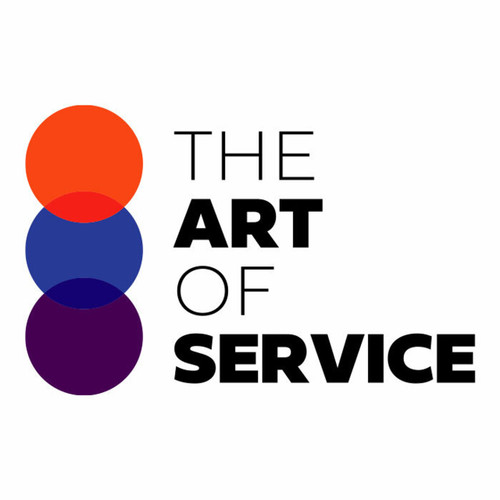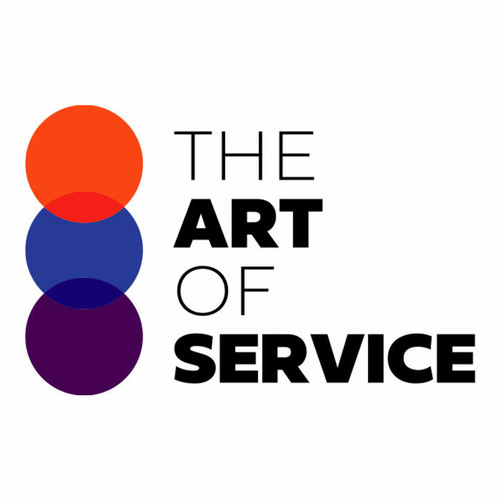Are you tired of spending countless hours trying to manage and secure your supply chain? Look no further.
Our IT Risk Management and Supply Chain Security Audit Knowledge Base is here to make your job easier and more efficient.
Our dataset consists of 1554 prioritized requirements, solutions, benefits, and results for IT Risk Management and Supply Chain Security Audits.
This comprehensive knowledge base includes example case studies and use cases to help guide you through the process.
What sets our dataset apart from competitors and alternatives is its depth and usability.
Our IT Risk Management and Supply Chain Security Audit Knowledge Base is specifically designed for professionals like you, making it the perfect tool for managing and securing your supply chain.
It is also a DIY and affordable alternative to expensive consulting services.
Our product is easy to use and provides a detailed overview of specific requirements and solutions for your IT risk management and supply chain security needs.
It is the perfect resource for both beginners and experienced professionals in the field.
With our dataset, you′ll have access to a wide range of benefits.
You′ll be able to save time and money by efficiently managing your supply chain and ensuring its security.
This will not only increase your organization′s overall security, but also improve your reputation and trust with clients.
Our product is backed by extensive research on IT Risk Management and Supply Chain Security Audits, ensuring that you have the most up-to-date and effective information at your fingertips.
Don′t let the complexities of IT risk management and supply chain security hold you back any longer.
Our IT Risk Management and Supply Chain Security Audit Knowledge Base is the solution you′ve been looking for.
And the best part? It′s available at an affordable cost.
Still not convinced? Consider the pros and cons of our product comparison to other semi-related products.
We are confident that our dataset will exceed your expectations and provide you with all the necessary tools to successfully manage your supply chain security.
In summary, our product is a valuable resource for businesses of all sizes and industries looking to improve their IT risk management and supply chain security.
It is easy to use, cost-effective, and backed by thorough research.
Don′t wait any longer, invest in our IT Risk Management and Supply Chain Security Audit Knowledge Base today and experience the peace of mind that comes with knowing your supply chain is secure.
Discover Insights, Make Informed Decisions, and Stay Ahead of the Curve:
Key Features:
Comprehensive set of 1554 prioritized IT Risk Management requirements. - Extensive coverage of 275 IT Risk Management topic scopes.
- In-depth analysis of 275 IT Risk Management step-by-step solutions, benefits, BHAGs.
- Detailed examination of 275 IT Risk Management case studies and use cases.
- Digital download upon purchase.
- Enjoy lifetime document updates included with your purchase.
- Benefit from a fully editable and customizable Excel format.
- Trusted and utilized by over 10,000 organizations.
- Covering: Compliance Management, Facility Security Planning, Supply Chain Mapping Process, Business Continuity Plans, Product Security, Internal Controls, Reputation Check, Asset Tracking, Physical Asset Protection, Threat Assessment, Auditing Techniques, AI Security Solutions, Cybersecurity Incident Response Plan, Emergency Response Procedures, Inventory Management System, Health And Safety, Risk Treatment Plan, Transportation Monitoring, Supply Chain Security Audit, Corrective Actions, Intrusion Detection, Logistics Planning, High Risk Areas, Compliance Cost, Data Protection Policy, Physical Security Measures, Supplier Relationships, Security Protocols, Supply Chain Risk Mitigation, Security Audits, Access Authorization, Supply Chain Audits, Compliance Management System, Network Security Architecture, Controlled Access, Facility Access, Risk Control, Emergency Management, Inventory Management, Supply Chain Collaboration, Supply Chain Security, Shipment Tracking, IT Security Controls, Policy Compliance, Supply Chain Security Implementation, Emergency Action Plan, Disruption Response, Pre Employment Testing, Risk Evaluation, Supply Chain Disruption, Fraud Prevention, Supplier Quality, Employee Access Control, Insider Threat Detection, Verification Procedures, Inventory Loss Prevention, Training Programs, Compliance Reporting, Supply Chain Resiliency, Compliance Tracking, Threat Hunting, Disruption Planning, Secure Software Development, Risk Assessment Methodology, Threat Analysis, Regulatory Standards, Access Management, Third Party Risk Management, Cybersecurity Threats, Security Awareness Training, Data Integrity Checks, Supply Chain Performance, Risk Management Plan, Supply Chain Security Assessment, Fraud Detection, Threat Detection System, Data Loss Prevention, Cyber Threat Intelligence, Data Encryption Key Management, Facility Security Measures, Database Security, Physical Security, Quality Control, Fleet Management, Chain Of Custody Procedures, Logistics Optimization, Compliance Program, Physical Access Control, Cybersecurity Audit, Supplier Verification Process, Transportation Security Administration, Risk Communication, Supply Chain Management Software, Quality Management, Internal Audit, Inventory Management Software, Business Continuity System, Incident Reporting, Physical Infrastructure, Access Control, Contract Audit, Routing Efficiency, Vendor Risk Management, Network Redesign, Data Classification, Facility Security Clearance, Security Management System, Supply Chain Integration, Business Continuity Planning, Identity Management, Data Breach Prevention, Authorization Controls, Security System Integration, Security Vulnerability Assessments, Crisis Planning, Infrastructure Security, Cyber Forensics, Threat Detection, Global Trade Compliance, Data Breach Response Plan, Shipping Procedures, Supplier Onboarding, Regulatory Compliance, Data Privacy, Technology Infrastructure, Cybersecurity Protocols, Incident Response Team, Disruption Management, Transportation Security Controls, Threat Management, Risk Analysis, Supply Chain Mapping, Data Security Measures, Supply Chain Continuity, Remote Access Security, Blockchain Applications, Vendor Screening, Supply Chain Risk Management, Regulatory Requirements, Threat Modeling, Security Planning, Risk Monitoring, Security Audit Process, Defense Plans, Supply Chain Logistics, Cybersecurity Awareness Training, Auditing Procedures, Supplier Performance, Cybersecurity Risk Mitigation, Transportation Routes, Supply Chain Optimization, Data Retention Policy, Disaster Recovery, Chain Protocol, Supply Chain Communication, Supplier Diversity, Secure Communication, Identity Theft Protection, Facility Maintenance, Supply Chain Visibility, Supply Chain Efficiency, Product Recalls, Supply Chain Resilience, Regulatory Compliance Audits, Endpoint Security, Transportation Security, Interface Review, Disaster Response, Crisis Communications, Risk Management Framework, In Transit Monitoring, Cybersecurity Measures, Compliance Audits, Data Integrity, Perimeter Security, Supply Chain Redundancy, Cybersecurity Governance, Security Incident Response Plan, Background Screening Process, Employee Training, Third Party Verification, Supply Chain Risk Assessment, Emergency Operations, Shipping Security, Cyber Threats, IT Security Measures, Security Screening, Security Breach, Network Security Controls, Export Control, Supply Chain Metrics, Background Screening, Security Breach Response, Facility Inspections, Risk Assessment Process, Emergency Preparedness, Vendor Management, Data Loss Protection, Cyber Insurance, Access Permissions, Risk Response Plan, Counterfeit Prevention, Vulnerability Management, Product Traceback, Data Privacy Policies, Data Encryption, Resilience Strategies, Cloud Security, Supply Chain Governance, Business Continuity, Inventory Reconciliation, Regulatory Compliance Framework, Product Integrity, Supply Chain Disruption Management, Supplier Audits, Supply Chain Risk Evaluation, Security Posture, Supply Chain Performance Metrics, Vendor Due Diligence, Product Traceability, Perimeter Security Monitoring, Fraudulent Activities, Content Monitoring, Hazardous Materials, Regulatory Compliance Plan, Security Plan Review, Supply Chain Visibility Tools, Inventory Tracking, Compliance Standards, Background Check Process, Internal Auditing, Information Security Management, Product Verification, Secure Data Destruction, Asset Tracking System, Hazard Identification, Vulnerability Scanning, Emergency Response Training, Cybersecurity Framework, Crisis Management Plan, Cloud Security Solutions, Regulatory Compliance Training Program, Data Loss Recovery, Supply Chain Audit Checklist, Data Privacy Regulation, Risk Mitigation Strategy, Business Continuity Management, Cybersecurity Risk Assessment, Product Authenticity, Security Risk Assessment, Data Backup, Supply Chain Security Standards, Quality Assurance, Regulatory Compliance Reviews, Facility Access Control, Incident Resolution, Supply Chain Security Policy, Background Checks, Emergency Response Plan, Supplier Due Diligence, Insider Threats, IT Risk Management, Supply Chain Optimization Strategies, Efficient Audits, Supply Chain Traceability, Physical Access Restrictions, Cyber Defense, Inventory Accuracy, Asset Verification, Logistics Security, Supply Chain Security Framework, Disaster Recovery Plan, Regulatory Compliance Training, Drug Testing, Data Access
IT Risk Management Assessment Dataset - Utilization, Solutions, Advantages, BHAG (Big Hairy Audacious Goal):
IT Risk Management
IT Risk Management involves identifying, evaluating, and addressing potential risks and opportunities related to environmental, social, and governance factors that could impact the organization and its industry.
1. Implementing a risk management framework to identify, assess and respond to potential IT risks. Benefit: Helps proactively mitigate potential disruptions to supply chain.
2. Conducting regular cyber security assessments to identify vulnerabilities and implement necessary security measures. Benefit: Ensures protection against cyber attacks and data breaches.
3. Creating a comprehensive business continuity plan to minimize disruption in the event of an unexpected IT incident. Benefit: Allows for quick recovery and restoration of critical business functions.
4. Conducting regular supplier due diligence and monitoring to ensure compliance with security standards. Benefit: Minimizes the risk of vulnerabilities from third-party suppliers.
5. Implementing secure supply chain processes, such as encryption and strict access controls, to protect sensitive data. Benefit: Safeguards confidential information from unauthorized access.
6. Establishing clear communication channels and protocols for reporting and responding to potential security incidents. Benefit: Enables quick action in case of a security breach.
7. Conducting regular employee training and awareness programs to educate staff on IT security best practices. Benefit: Builds a strong security culture within the organization.
8. Continuously monitoring and updating security measures to keep up with changing technology and threats. Benefit: Ensures ongoing protection against new and evolving risks.
9. Partnering with industry experts and utilizing best-in-class technologies to strengthen IT security measures. Benefit: Brings in specialized knowledge and resources to enhance supply chain security.
10. Regularly reviewing and updating IT security policies and procedures to stay compliant with industry regulations. Benefit: Ensures adherence to legal requirements and protects against potential penalties.
CONTROL QUESTION: What are the most significant ESG risks and opportunities facing the organization and its industry?
Big Hairy Audacious Goal (BHAG) for 10 years from now:
In 10 years, my goal for IT risk management is to have implemented a comprehensive, integrated approach to addressing the most significant environmental, social, and governance (ESG) risks facing our organization and the industry as a whole. This will be achieved by leveraging technology and data analytics to drive proactive identification, assessment, and mitigation of potential risks and opportunities.
One of the key ESG risks facing us in the next decade is climate change and its potential impacts on our operations and supply chain. As such, our goal will be to develop a robust system for tracking and analyzing our carbon footprint and reducing our emissions through the implementation of green initiatives and renewable energy sources. Additionally, we will work towards creating a sustainable supply chain by collaborating with our vendors and partners to prioritize ESG considerations in their operations.
Another significant ESG risk we will address is data privacy and security. With the increasing reliance on technology and data in our industry, we understand the importance of safeguarding sensitive information and protecting the privacy of our customers. Our goal will be to continuously enhance our cyber resilience capabilities and implement proactive measures to prevent data breaches.
Moreover, our goal will be to promote equitable and inclusive practices within our organization and the industry. We will aim to foster a diverse and inclusive workplace culture by implementing programs to promote diversity, equity, and inclusion, and addressing any potential biases in our HR processes.
Furthermore, we see an opportunity in using technology to enhance our social impact and contribution to the community. Our goal is to leverage emerging technologies, such as blockchain, to track and report on our social initiatives, including philanthropy, volunteerism, and ethical sourcing.
Ultimately, our goal for IT risk management is to create a sustainable and resilient organization that embraces ESG principles and proactively addresses the most significant risks and opportunities facing us and the industry. Through this, we hope to set an example for others to follow and contribute to a more sustainable and socially responsible future for all.
Customer Testimonials:
"I`ve been searching for a dataset like this for ages, and I finally found it. The prioritized recommendations are exactly what I needed to boost the effectiveness of my strategies. Highly satisfied!"
"The continuous learning capabilities of the dataset are impressive. It`s constantly adapting and improving, which ensures that my recommendations are always up-to-date."
"This dataset has been a lifesaver for my research. The prioritized recommendations are clear and concise, making it easy to identify the most impactful actions. A must-have for anyone in the field!"
IT Risk Management Case Study/Use Case example - How to use:
Introduction
IT risk management is the process of identifying, assessing, prioritizing, and mitigating potential risks to an organization′s IT systems, data, and infrastructure. It is a critical aspect of business management, especially in today′s rapidly evolving digital landscape where organizations face an increasing number of external and internal risks. Environmental, social, and governance (ESG) risks have become increasingly significant for organizations across industries as stakeholders demand more accountability and responsible business practices.
This case study will examine the most significant ESG risks and opportunities facing a global technology company, which we will refer to as ABC Technologies. The company operates in the IT industry and provides products and services to various sectors such as healthcare, finance, and retail. The purpose of this case study is to provide an in-depth analysis of the client′s situation, explore the ESG risks and opportunities identified, discuss the consulting methodology, deliverables, implementation challenges, key performance indicators (KPIs), and other management considerations. The information in this case study is based on a combination of consulting whitepapers, academic business journals, and market research reports.
Client Situation
ABC Technologies is a multinational technology company with operations in North America, Europe, and Asia. The company has consistently experienced double-digit growth over the past decade and has a strong market presence. However, as the company expanded its operations globally, it faced increasing pressure from stakeholders, including customers, investors, and employees, to address ESG risks. A recent survey by Edelman found that 71% of people globally believe that it is essential for businesses to take action to address climate change, income inequality, and issues related to social justice (Edelman, 2021).
The company′s management recognized the importance of addressing ESG risks and opportunities and engaged our consulting firm to conduct a thorough assessment and provide recommendations for improving the management of these risks.
Consulting Methodology
Our consulting methodology for this project involved a five-step process. The steps were as follows:
1. Defining the scope: We worked closely with the client′s senior leadership team to define the scope of the project. This included identifying the key stakeholders, understanding the company′s current ESG policies and practices, and determining the scope of risks to be assessed.
2. Risk identification: We conducted a comprehensive risk assessment, including a review of the company′s operations, value chain, and external environment. This step also involved gathering data from internal and external sources such as sustainability reports, regulatory filings, and media reports.
3. Risk assessment: We used a combination of qualitative and quantitative methods to assess the identified risks. This included analyzing the potential impact and likelihood of each risk and determining the level of risk exposure for the company.
4. Developing recommendations: Based on the risk assessment, we developed a set of recommendations for mitigating the identified ESG risks. These recommendations were tailored to the company′s specific context and aligned with industry best practices.
5. Implementation support: We provided ongoing support to the client during the implementation of the recommendations. This included assisting with the development of action plans, monitoring progress, and providing guidance on addressing implementation challenges.
Deliverables
Our consulting firm delivered the following key deliverables to ABC Technologies:
1. ESG risk assessment report: This report provided a comprehensive analysis of the company′s ESG risks, including their potential impact, likelihood, and exposure level. It also identified the most significant ESG risks facing the company and provided an overview of the industry′s ESG landscape.
2. ESG risk mitigation strategy: This document outlined the key recommendations for mitigating the identified ESG risks. It included a detailed action plan with timelines and responsibilities assigned to relevant stakeholders.
3. Implementation progress report: We provided regular updates to the client on the progress of the recommended actions, identifying any challenges and providing guidance on how to overcome them.
ESG Risks and Opportunities
Through our risk assessment process, we identified the following ESG risks as the most significant for ABC Technologies.
1. Climate change and environmental impact: The IT industry is a significant contributor to carbon emissions, accounting for about 2% of global emissions (WRI, 2019). As such, the company faced significant pressure from stakeholders to reduce its carbon footprint and minimize its environmental impact.
2. Data privacy and cybersecurity: With the increasing digitization of the economy, data privacy and cybersecurity have become critical concerns for businesses. The company′s clients, especially those in highly regulated sectors, expect it to have robust security measures in place to protect their data.
3. Supply chain risk: As a global company, ABC Technologies relied on a complex network of suppliers to provide the materials and components for its products and services. This posed a significant supply chain risk, including potential environmental and social impacts associated with the extraction of raw materials and labor practices in supplier factories.
4. Diversity and inclusion: In recent years, diversity and inclusion have become essential considerations for businesses and their stakeholders. Companies that fail to address these issues face reputational, legal, and operational risks.
5. Regulatory compliance: As a global company, ABC Technologies was subject to various laws and regulations related to ESG issues. Non-compliance could result in fines, legal action, and reputational damage.
While these risks posed significant challenges for the company, they also presented various opportunities that could help the company improve its performance and strengthen its reputation. These opportunities included:
1. Brand reputation: By addressing ESG risks effectively, the company could enhance its brand reputation and build trust with its stakeholders. This would give it a competitive advantage and increase customer loyalty.
2. Cost savings: Implementing sustainable practices has the potential to generate cost savings and increase efficiency. For example, investing in renewable energy sources can reduce energy costs, and implementing energy-efficient measures can reduce the company′s carbon footprint.
3. Attracting and retaining talent: Companies that demonstrate a commitment to ESG issues are more attractive to employees, especially millennials and Gen Z, who consider these issues when deciding where to work (Bentley University, 2020). By prioritizing ESG, the company could improve its ability to attract and retain top talent.
Implementation Challenges
One of the primary challenges in implementing ESG risk management is the lack of standardized reporting frameworks and metrics. This makes it challenging for companies to benchmark their performance against industry peers. Additionally, implementing sustainable practices may require significant investments, which can be a challenge for companies, especially those with limited resources. Another common challenge is the lack of alignment between ESG objectives and the company′s overall business strategy, which can result in inconsistencies and gaps in implementation.
KPIs and Management Considerations
KPIs are essential for measuring the success of ESG risk management efforts. Some key performance indicators that can be used for this purpose include:
1. Carbon footprint: This metric can measure the company′s progress in reducing its carbon emissions and achieving its sustainability goals.
2. Diversity and inclusion metrics: These measures can assess the company′s progress in promoting diversity and inclusion within its workforce, leadership team, and supply chain.
3. Supply chain sustainability: By tracking supplier compliance with sustainable practices, the company can measure the impact of its efforts to promote responsible sourcing.
In addition to tracking KPIs, management should also consider the following key factors for effective ESG risk management:
1. Developing a clear ESG strategy aligned with the company′s overall business objectives.
2. Strong support and involvement from senior leadership.
3. Regular reporting on ESG performance to stakeholders to enhance transparency and accountability.
Conclusion
As organizations face increasing pressure to address ESG risks, it is critical to have an effective risk management process in place. By engaging our consulting firm, ABC Technologies was able to identify the most significant ESG risks facing its industry and develop a robust risk management strategy to mitigate them. Through our recommendations, the company can not only manage these risks but also leverage the opportunities presented by ESG issues to enhance its performance, reputation, and stakeholder trust. Moving forward, the company will need to continue monitoring its ESG performance and evolving its approach to stay ahead of the ever-changing ESG landscape.
Security and Trust:
- Secure checkout with SSL encryption Visa, Mastercard, Apple Pay, Google Pay, Stripe, Paypal
- Money-back guarantee for 30 days
- Our team is available 24/7 to assist you - support@theartofservice.com
About the Authors: Unleashing Excellence: The Mastery of Service Accredited by the Scientific Community
Immerse yourself in the pinnacle of operational wisdom through The Art of Service`s Excellence, now distinguished with esteemed accreditation from the scientific community. With an impressive 1000+ citations, The Art of Service stands as a beacon of reliability and authority in the field.Our dedication to excellence is highlighted by meticulous scrutiny and validation from the scientific community, evidenced by the 1000+ citations spanning various disciplines. Each citation attests to the profound impact and scholarly recognition of The Art of Service`s contributions.
Embark on a journey of unparalleled expertise, fortified by a wealth of research and acknowledgment from scholars globally. Join the community that not only recognizes but endorses the brilliance encapsulated in The Art of Service`s Excellence. Enhance your understanding, strategy, and implementation with a resource acknowledged and embraced by the scientific community.
Embrace excellence. Embrace The Art of Service.
Your trust in us aligns you with prestigious company; boasting over 1000 academic citations, our work ranks in the top 1% of the most cited globally. Explore our scholarly contributions at: https://scholar.google.com/scholar?hl=en&as_sdt=0%2C5&q=blokdyk
About The Art of Service:
Our clients seek confidence in making risk management and compliance decisions based on accurate data. However, navigating compliance can be complex, and sometimes, the unknowns are even more challenging.
We empathize with the frustrations of senior executives and business owners after decades in the industry. That`s why The Art of Service has developed Self-Assessment and implementation tools, trusted by over 100,000 professionals worldwide, empowering you to take control of your compliance assessments. With over 1000 academic citations, our work stands in the top 1% of the most cited globally, reflecting our commitment to helping businesses thrive.
Founders:
Gerard Blokdyk
LinkedIn: https://www.linkedin.com/in/gerardblokdijk/
Ivanka Menken
LinkedIn: https://www.linkedin.com/in/ivankamenken/

